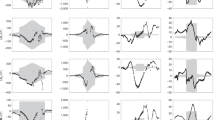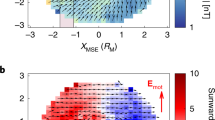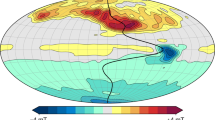Abstract
The Juno spacecraft, which is in a polar orbit around Jupiter, is providing direct measurements of the planet’s magnetic field close to its surface1. A recent analysis of observations of Jupiter’s magnetic field from eight (of the first nine) Juno orbits has provided a spherical-harmonic reference model (JRM09)2 of Jupiter’s magnetic field outside the planet. This model is of particular interest for understanding processes in Jupiter’s magnetosphere, but to study the field within the planet and thus the dynamo mechanism that is responsible for generating Jupiter’s main magnetic field, alternative models are preferred. Here we report maps of the magnetic field at a range of depths within Jupiter. We find that Jupiter’s magnetic field is different from all other known planetary magnetic fields. Within Jupiter, most of the flux emerges from the dynamo region in a narrow band in the northern hemisphere, some of which returns through an intense, isolated flux patch near the equator. Elsewhere, the field is much weaker. The non-dipolar part of the field is confined almost entirely to the northern hemisphere, so there the field is strongly non-dipolar and in the southern hemisphere it is predominantly dipolar. We suggest that Jupiter’s dynamo, unlike Earth’s, does not operate in a thick, homogeneous shell, and we propose that this unexpected field morphology arises from radial variations, possibly including layering, in density or electrical conductivity, or both.
This is a preview of subscription content, access via your institution
Access options
Access Nature and 54 other Nature Portfolio journals
Get Nature+, our best-value online-access subscription
$29.99 / 30 days
cancel any time
Subscribe to this journal
Receive 51 print issues and online access
$199.00 per year
only $3.90 per issue
Buy this article
- Purchase on Springer Link
- Instant access to full article PDF
Prices may be subject to local taxes which are calculated during checkout



Similar content being viewed by others
References
Connerney, J. E. P. et al. The Juno magnetic field investigation. Space Sci. Rev. 213, 39–138 (2017).
Connerney, J. E. P. et al. A new model of Jupiter’s magnetic field from Juno’s first nine orbits. Geophys. Res. Lett. 45, 2590–2596 (2018).
Liu, J., Goldreich, P. M. & Stevenson, D. J. Constraints on deep-seated zonal winds inside Jupiter and Saturn. Icarus 196, 653–664 (2008).
Gastine, T., Wicht, J., Duarte, L., Heimpel, M. & Becker, A. Explaining Jupiter’s magnetic field and equatorial jet dynamics. Geophys. Res. Lett. 41, 5410–5419 (2014).
Cao, H. & Stevenson, D. J. Zonal flow magnetic field interaction in the semi-conducting region of giant planets. Icarus 296, 59–72 (2017).
Nellis, W. J., Weir, S. T. & Mitchell, A. C. Metallization and electrical conductivity of hydrogen in Jupiter. Science 273, 936–938 (1996).
French, M. et al. Ab initio simulations for material properties along the Jupiter adiabat. Astrophys. J. Suppl. Ser. 202, 5 (2012).
Shure, L., Parker, R. L. & Backus, G. E. Harmonic splines for geomagnetic modelling. Phys. Earth Planet. Inter. 28, 215–229 (1982).
Moore, K. M., Bloxham, J., Connerney, J. E. P., Jørgensen, J. L. & Merayo, J. M. G. The analysis of initial Juno magnetometer data using a sparse magnetic field representation. Geophys. Res. Lett. 44, 4687–4693 (2017).
Christensen, U. R. & Aubert, J. Scaling properties of convection-driven dynamos in rotating spherical shells and application to planetary magnetic fields. Geophys. J. Int. 166, 97–114 (2006).
Jones, C. A. A dynamo model of Jupiter’s magnetic field. Icarus 241, 148–159 (2014).
Ridley, V. A. & Holme, R. Modeling the Jovian magnetic field and its secular variation using all available magnetic field observations. J. Geophys. Res. Planets 121, 309–337 (2016).
Jones, C. A. Planetary magnetic fields and fluid dynamos. Annu. Rev. Fluid Mech. 43, 583–614 (2011).
Duarte, L. D. V., Wicht, J. & Gastine, T. Physical conditions for Jupiter-like dynamo models. Icarus 299, 206–221 (2018).
Grote, E. & Busse, F. H. Hemispherical dynamos generated by convection in rotating spherical shells. Phys. Rev. E 62, 4457–4460 (2000).
Salpeter, E. E. On convection and gravitational layering in Jupiter and in stars of low mass. Astrophys. J. 181, L83–L86 (1973).
Stevenson, D. J. Reducing the non-axisymmetry of a planetary dynamo and an application to Saturn. Geophys. Astrophys. Fluid Dyn. 21, 113–127 (1982).
Stanley, S. & Mohammadi, A. Effects of an outer thin stably stratified layer on planetary dynamos. Phys. Earth Planet. Inter. 168, 179–190 (2008).
Dietrich, W. & Jones, C. A. Anelastic spherical dynamos with radially variable electrical conductivity. Icarus 305, 15–32 (2018).
Glatzmaier, G. A. Computer simulations of Jupiter’s deep internal dynamics help interpret what Juno sees. Proc. Natl Acad. Sci. USA 115, 6896–6904 (2018).
Stevenson, D. J. Cosmochemistry and structure of the giant planets and their satellites. Icarus 62, 4–15 (1985).
Wilson, H. F. & Militzer, B. Rocky core solubility in Jupiter and giant exoplanets. Phys. Rev. Lett. 108, 111101 (2012).
Wilson, H. F. & Militzer, B. Solubility of water ice in metallic hydrogen: consequences for core erosion in gas giant planets. Astrophys. J. 745, 54 (2012).
Wahl, S. M., Wilson, H. F. & Militzer, B. Solubility of iron in metallic hydrogen and stability of dense cores in giant planets. Astrophys. J. 773, 95 (2013).
González-Cataldo, F., Wilson, H. F. & Militzer, B. Ab initio free energy calculations of the solubility of silica in metallic hydrogen and application to giant planet cores. Astrophys. J. 787, 79 (2014).
Helled, R. & Stevenson, D. The fuzziness of giant planets’ cores. Astrophys. J. Lett. 840, L4 (2017).
Vazan, A., Helled, R. & Guillot, T. Jupiter’s evolution with primordial composition gradients. Astron. Astrophys. 610, L14 (2018).
Wahl, S. M. et al. Comparing Jupiter interior structure models to Juno gravity measurements and the role of a dilute core. Geophys. Res. Lett. 44, 4649–4659 (2017).
Stanley, S. & Bloxham, J. Numerical dynamo models of Uranus’ and Neptune’s magnetic fields. Icarus 184, 556–572 (2006).
Bolton, S. J. et al. The Juno mission. Space Sci. Rev. 213, 5–37 (2017).
Acknowledgements
All authors acknowledge support from the Juno project. K.M.M. is supported by the US Department of Defense (DoD) through the National Defense Science and Engineering Graduate Fellowship (NDSEG) programme and L.K. through a US National Science Foundation Graduate Fellowship.
Reviewer information
Nature thanks C. Jones and the other anonymous reviewer(s) for their contribution to the peer review of this work.
Author information
Authors and Affiliations
Contributions
K.M.M. and J.B. wrote the manuscript and performed the data analysis. K.M.M., J.B., J.E.P.C., S.K., J.L.J. and J.M.G.M. contributed to discussions of the data analysis, and K.M.M., R.K.Y., L.K., H.C., J.B. and D.J.S. contributed to discussions of the dynamo implications. All authors contributed to editing and revising the manuscript. J.E.P.C. is principal investigator of the Juno magnetometer investigation, S.J.B. is principal investigator of the mission and S.M.L. is project scientist of the mission.
Corresponding author
Ethics declarations
Competing interests
The authors declare no competing interests.
Additional information
Publisher’s note: Springer Nature remains neutral with regard to jurisdictional claims in published maps and institutional affiliations.
Rights and permissions
About this article
Cite this article
Moore, K.M., Yadav, R.K., Kulowski, L. et al. A complex dynamo inferred from the hemispheric dichotomy of Jupiter’s magnetic field. Nature 561, 76–78 (2018). https://doi.org/10.1038/s41586-018-0468-5
Received:
Accepted:
Published:
Issue Date:
DOI: https://doi.org/10.1038/s41586-018-0468-5
Keywords
This article is cited by
-
Existence of Homogeneous Euler Flows of Degree \(-\alpha \notin [-2,0]\)
Archive for Rational Mechanics and Analysis (2024)
-
Jupiter’s cloud-level variability triggered by torsional oscillations in the interior
Nature Astronomy (2023)
-
The turbulent dynamics of Jupiter’s and Saturn’s weather layers: order out of chaos?
Geoscience Letters (2020)
-
Understanding dense hydrogen at planetary conditions
Nature Reviews Physics (2020)
-
Comparison of the Deep Atmospheric Dynamics of Jupiter and Saturn in Light of the Juno and Cassini Gravity Measurements
Space Science Reviews (2020)
Comments
By submitting a comment you agree to abide by our Terms and Community Guidelines. If you find something abusive or that does not comply with our terms or guidelines please flag it as inappropriate.



